Wigan Wallgate Station War Memorial
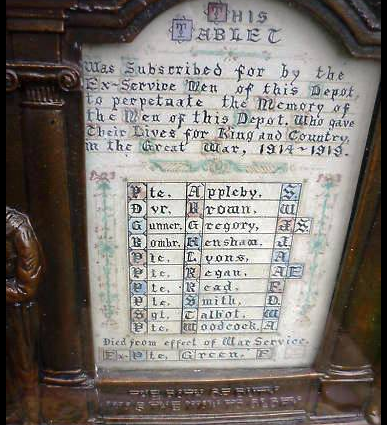
Introduction
The First World War memorial depicted was advertised for sale on eBay and purchased by a member of the Great War Forum on 9 June 2010. Members of the forum determined that it commemorated eleven employees of the Lancashire & Yorkshire Railway (L&YR) based in Wigan and initiated preliminary military research.
The memorial is officially registered with the Commonwealth War Graves Commission (CWGC) as the 'Wigan Wallgate Station War Memorial'. The Great War commenced for Great Britain on 4 August 1914 and although hostilities ceased with the signing of the Armistice, which ended fighting on 11 November 1918, the First World War did not end officially until the Treaty of Versailles was signed on 28 June 1919.
The tablet commemorates ten employees of the L&YR who died during the above dates and were eligible for military funerals and commemorations plus one other who died later out of service, due to wounds or sickness suffered during the conflict.
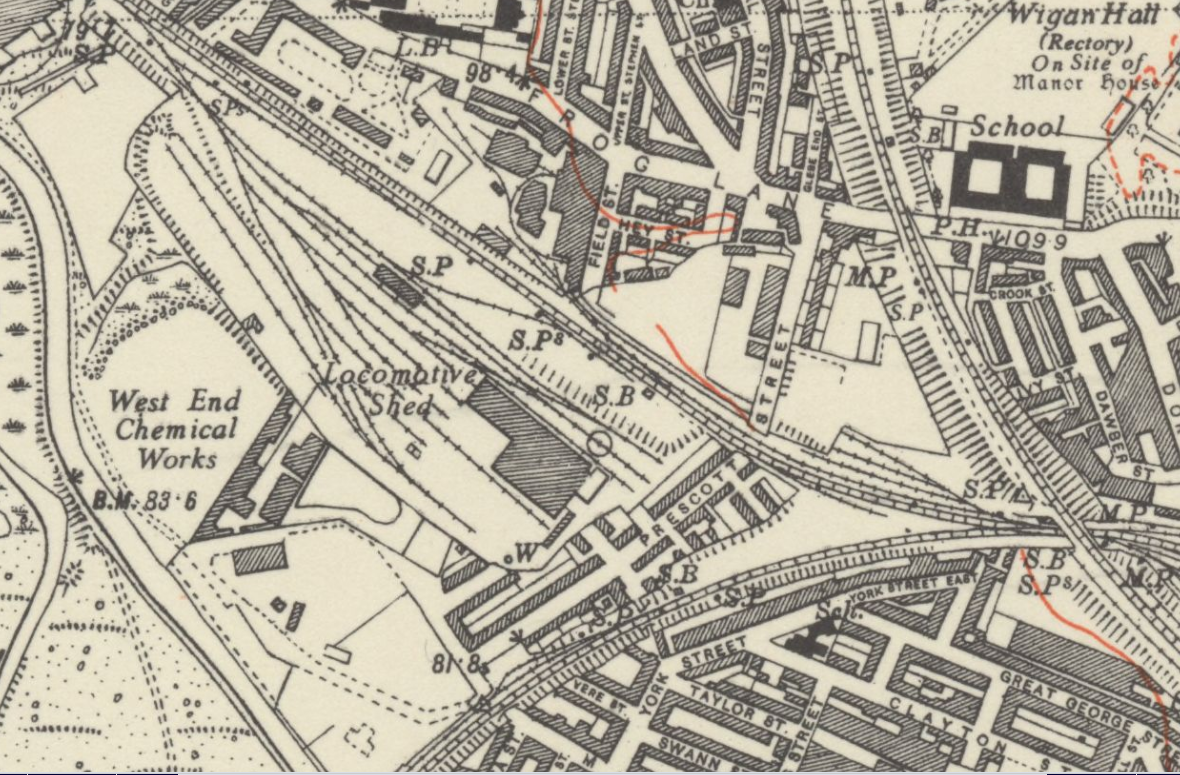 Location of L&YR loco sheds, Prescott St, Wigan
Location of L&YR loco sheds, Prescott St, Wigan
The memorial was unveiled in 1923 in the L&YR locomotive sheds located in Cricket Street, off Prescott Street in Wigan. The depot opened in 1896, closed in April 1964 and was demolished in 1966. The site is now occupied by a light industrial estate, the Cricket Street Business Park.
 L&YR Loco sheds, Prescott St, Wigan
L&YR Loco sheds, Prescott St, Wigan
Lancashire & Yorkshire Railway ( L&YR)
The Lancashire & Yorkshire Railway was a major British Railway company. It was incorporated in 1847 from an amalgamation of several existing railways and was the third largest railway system in northern England after the Midland Railway and the North East Railway.
During the Great War the L&YR contributed to the war effort by producing, at it's Horwich Loco Works, specially adapted hospital trains for transporting the injured to hospitals along the evacuation trail. They also produced lumbers and axles for Howitzer artillery pieces as well as carrying out other contract work with Woolwich Arsenal.
On 1 January 1922 the L&YR amalgamated with the London & North Western Railway (LNWR). Exactly a year later under an exercise known as the ‘1923 Grouping’, twenty four Railway companies were grouped into four main companies. These were often termed the ‘The Big Four’ and consisted of the Great Western Railway (GWR), London & North Eastern Railway (LNER). London Midland & Scottish Railway (LMSR), and Southern Railways (SR).
In World War One, from over 40,000 employees of the L&YR, over a quarter, 10,422 joined the Armed Forces. Of these 1,465 lost their lives, in addition a total of 248 L&YR employees were awarded Military Honours.
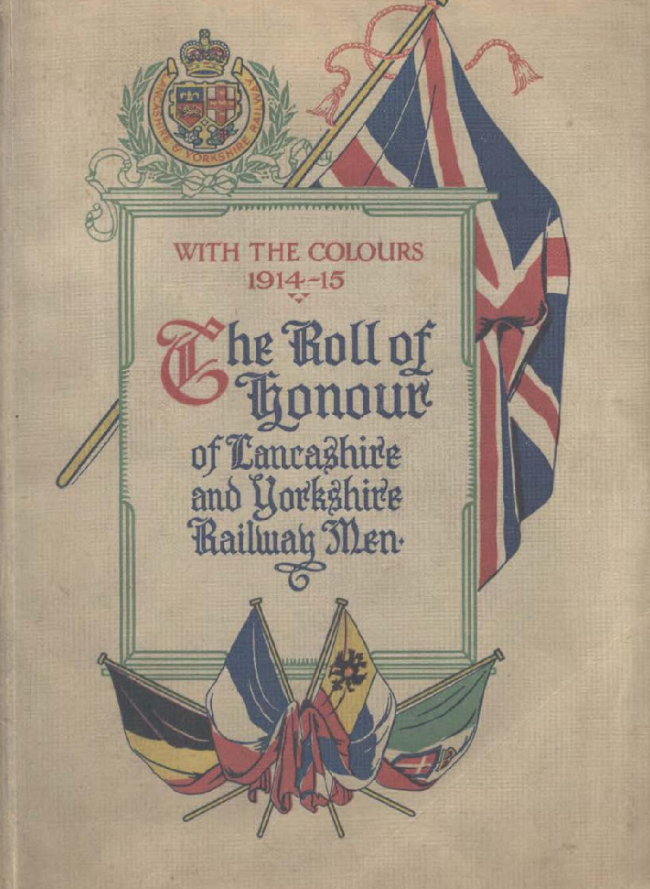 L&YR 1915 Roll of Honour
L&YR 1915 Roll of Honour
Two Rolls of Honour were printed by the L&YR. The first one published in 1915, included a list of employees who were serving in the Armed Forces, with the Regiments they had enlisted in. The second Roll of Honour printed in 1919 lists in alphabetical order all employees who had lost their lives, but by name and initial only.
On a wall at Victoria Station is a huge ceramic map depicting the routes of the Lancashire and Yorkshire Railway system. Below the map a bronze memorial tablet was unveiled by Field Marshal The Earl Haig on 14th February 1922, it reads.
'This tablet is erected to perpetuate the memory of the men of the Lancashire and Yorkshire Railway whose names are recorded here and who gave their lives for their King and Country in the Great War 1914 – 1919'
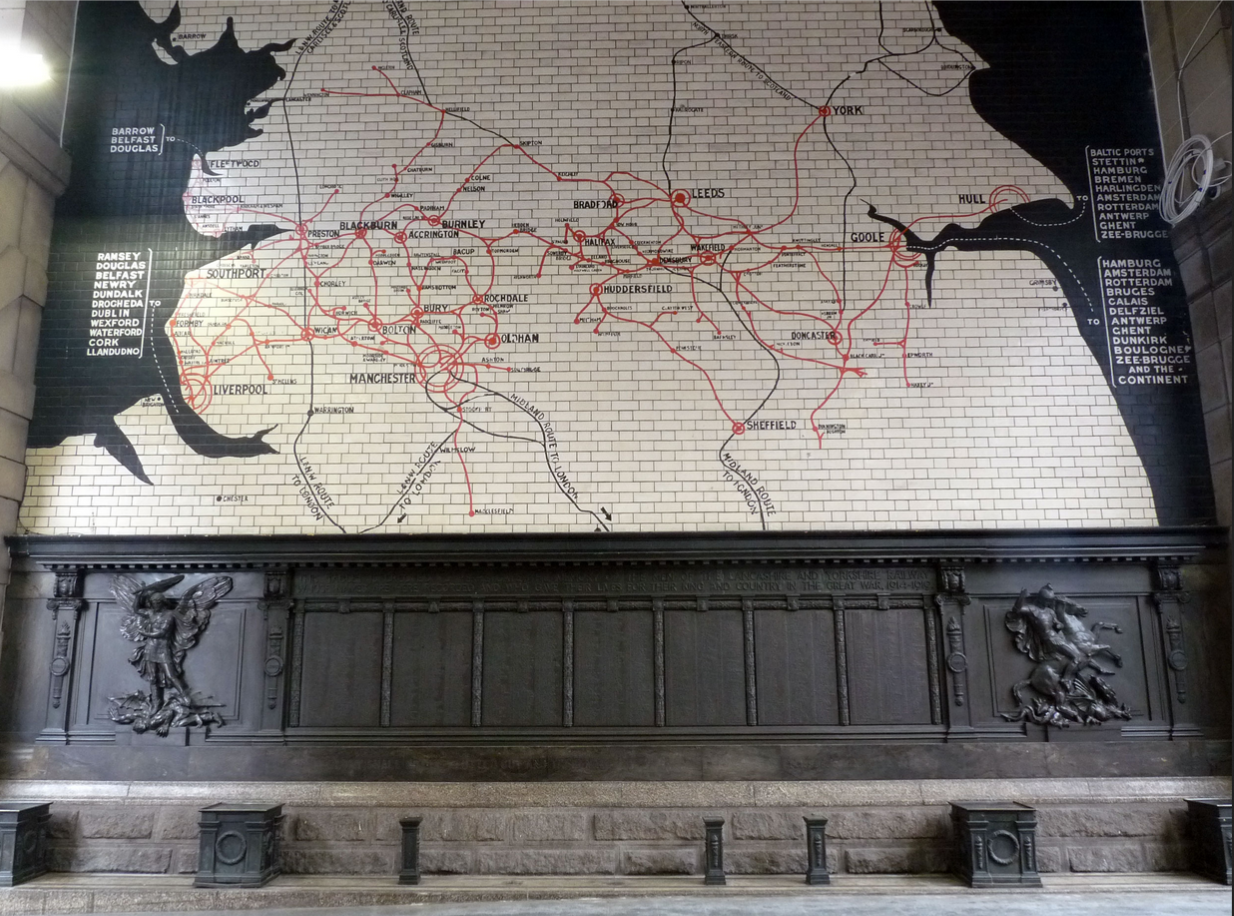 L&YR Memorial Victoria Station, Manchester
L&YR Memorial Victoria Station, Manchester
The Wallgate Station Memorial
All of the names on the Wallgate Memorial are on the L&YR 1915 Roll of Honour, therefore they must have enlisted in the first year of the war up to 31 August 1915. Of the ones who died during the war years all but one are commemorated on the Wigan Cenotaph. The memorial was funded by subscription by the workmates of the fallen and was in a commercially available wooden frame containing carvings made of plaster with a bronze finish. The inscription reads.
'THIS TABLET
Was subscribed for by the
Ex-Servicemen of this Depot
to perpetuate the memory of
the Men of this Depot, who gave
Their lives for King and Country in the Great War, 1914-1919'
Above the inscription is the Winged Victory figure holding a wreath with both hands. To the right is a soldier with rifle reversed and a sailor to the left likewise. Underneath is the carved inscription.
'THE PATH OF DUTY
WAS THE WAY TO GLORY'
Beneath that are furled flags. The calligraphic Roll of Honour showing the details of the soldiers is in the centre on a white background. At the bottom is another line with the words. ‘Died from effect of War Service’ with the details of one soldier.
 Wigan Wallgate Station War Memorial
Wigan Wallgate Station War Memorial
The tablet is marked ‘John M. Stamper 1923 Reg No 659624’. John Mallinson Stamper was a painter and sign writer employed by Messrs Lea & Son of Rodney Street, Wigan. John was born 20 February 1888 in Penrith, Cumberland, his family moved to Moss Lane, Hindley in the 1890’s, but by the time of the 1911 census were living at 54 Barnsley Street, Wigan.
In 1913 John married Caroline Causey at St. Michael’s & All Angels CE church in Swinley. The couple then lived at 3a Alfred Street, Swinley, a few doors away from her family home at number 19. John died on 12 December 1982 at Sherwood House Elderly Persons Home, Platt Bridge, aged 94.
John’s brother Philip Amos Stamper worked at the locomotive depot as a cleaner so was probably involved in securing the memorial contract for his brother. Their father John also worked on the railways as a signalman.
Philip who is also listed on the L&YR 1915 Roll of Honour was a member of the Territorial Force and served with 1/5th Battalion Manchester Regiment in Gallipoli where he was wounded twice. Firstly as a Corporal with ‘C’ Company, he received shrapnel wounds to his shoulder, arm, and hand on 4 June at the Third Battle of Krithia.
He was evacuated to hospital in Malta for treatment. On his return to the peninsula he was wounded again on 7 August by shellfire during the Battle of Krithia Vineyard (the same battle that the author’s grandfather was shot and wounded). In April 1917 1/5th Battalion was posted to the Western Front, seven months later on 16 November 1917 Philip was awarded the Military Medal for bravery in the field.
He survived the war, was disembodied from active service on 31 March 1919, and returned to his old job as a cleaner at the loco sheds. As well as the Military Medal he was awarded the 1914-1915 Star, British War Medal and Victory Medal.
The 1921 census shows that he had been promoted to engine fireman and was living at 138 Gidlow Lane with his parents, a brother and a sister. He married Ann Thomason in 1922, a daughter, Margaret was born to them in 1927. The 1939 Register taken at the start of the Second World War shows them living at 22 Hodges Street and that his occupation was now a locomotive driver. Philip died in Wigan on 21 July 1951 aged 57.
The names of the Fallen
12243 Gunner Sydney Appleby
Sydney was born 14 June 1894 at 21 William Street, Lower Ince, Wigan, to Joseph and Mary Appleby (nee Makinson). He was baptised six weeks later, on 29 July, at St. James’s CE Church, Poolstock. The 1911 census finds him living with his widowed mother, two sisters and a brother at 176 Poolstock Lane, Wigan. His occupation is shown as a labourer at a coal mine. He later became a cleaner at the locomotive depot.
Sydney enlisted at Wigan in 1915 into the Royal Field Artillery and was posted to ‘A’ Battery, 86th (Howitzer) Brigade belonging to the 19th Divisional Artillery. He entered the theatre of war in France on 17 July 1915 and was killed in action a year later on 25 July 1916 during the Battle of the Somme, aged 21.
Sydney has no known grave and is commemorated on the Thiepval Memorial in France, Pier and Face 1A and 8A. He is also remembered on the L&YR Manchester Victoria Station memorial and Wigan Cenotaph. He was awarded the 1914/15 Star, British War Medal and Victory Medal.
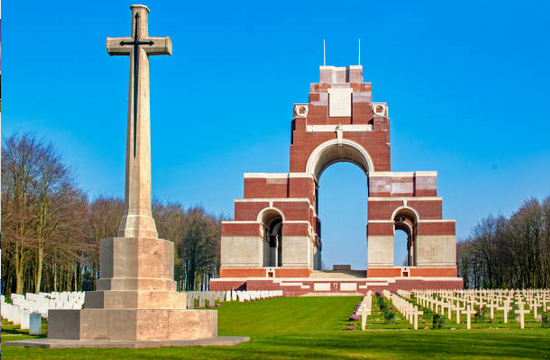 Thiepvaal Memorial and Anglo-French Cemetery, Somme, France
Thiepvaal Memorial and Anglo-French Cemetery, Somme, France
L17522 Driver William Brown, Royal Field Artillery
William was born 24 December 1893 at 47 Bolton Street, Scholes, the eldest child of James and Millicent Brown (nee Davis). He was baptised at St. Catharines CE church on 4 February 1894. In 1911 the family was living at 3 Scott Street off Gidlow Lane and William is shown aged 17 and employed as an engine cleaner. At some point they moved to 16 Mort Street, off Springfield Road. His father James, a joiner, died in 1915, the same year that William enlisted into the army at Wigan.
William was posted into the 31st Division Ammunition Column, Royal Field Artillery and entered the Middle Eastern Theatre of War on 25 December 1915 when the division disembarked at Port Said in Egypt, taking over the No 3 Sector of the Suez Canal defences. The stay in Egypt was short, and between 1st to 6th March the Division sailed to Marseilles for service on the Western Front.
William's rank of Driver shows he was one of the men who drove the teams of horses which pulled the guns. He was killed in action on 16 July 1916, aged 22 in the Battle of Fromelles. He is buried in Laventie Military Cemetery, La Gorgue, in Northern France, Plot II, Row ‘C‘, Grave 14. He is also commemorated on the L&YR Victoria Station memorial and Wigan Cenotaph. He was awarded the 1914-195 Star, British War Medal and Victory Medal.
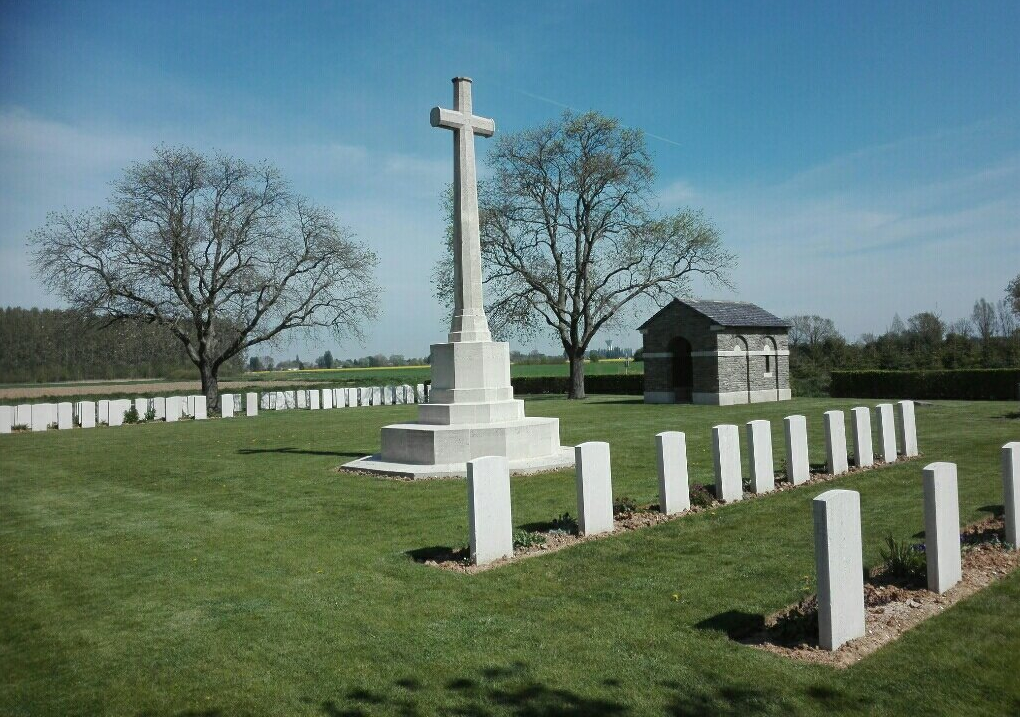 Laventie Communal Cemetery, Pas de Calais, France
Laventie Communal Cemetery, Pas de Calais, France
12243 Bombardier James Shacklady Gregory, Royal Field Artillery
James was born 5 March 1896 at 2 Regent Street, Scholes, Wigan to William and Margaret Gregory (nee Shacklady), and baptised at St. Catharine CE Church on 19 April of that year. On the 1911 census he is living with his widowed mother, two sisters and a brother at 7 Lathams Yard, Millgate, Wigan. His occupation is shown as an errand boy for a wines and spirits merchant.
James enlisted in August 1914 at Wigan into the Royal Field Artillery and disembarked at Alexandria in Egypt on 1 July 1915. He was later posted to 463rd Battery, 179th Brigade on the Western Front. James died of bronchial pneumonia, aged 23, in a military hospital at Camiers, France. He was buried in Etaples Military Cemetery, Pas-de-Calais, France, Plot LXII, Row C, Grave 36.
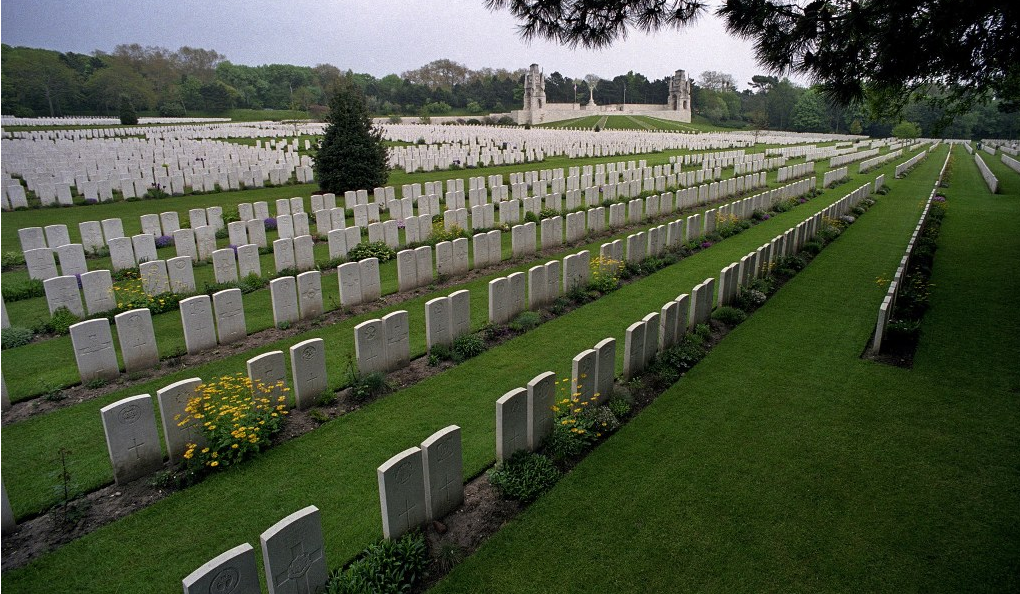 Etaples Military Cemetery, Pas de Calais, France
Etaples Military Cemetery, Pas de Calais, France
A poignant personal message inscribed on James's headstone reads
'Freed from all Sorrows grief and Pain.
Our Loss is his Eternal Gain. From Mother brother and Sisters’.
James is also commemorated on the L&YR Manchester Victoria Station Memorial and Wigan Cenotaph. He was awarded the 1914-1915 Star, British War Medal and Victory Medal.
70397 Bombardier James Henshaw, Royal Field Artillery
James was born on 28 December 1894 in Lowton and baptised at St. Luke’s CE church on 27 January 1895. His father Henry died in 1896 aged thirty five when James was just eighteen months old. His mother Mary Ann (nee Ormshaw) remarried the following year to William Lewis Sollars and the 1901 census found the family living at 3 Stonecross Lane in Lowton.
Sometime before 1911 they moved to Wigan where the census shows them living at 10 Low Street, off School Lane in Scholes. James was working as a jobber in a cotton factory card room. Later he gained employment at the L&Y Loco sheds as an engine cleaner.
James’s service records survived but are partly illegible due to fire and water damage suffered during the Blitz in 1940. He enlisted into the Royal Field Artillery in Wigan on 11 January 1915, aged 20. His medical records show him to be 5 ft 6 and three quarter inches in height and weighing 9 stones 10 lbs. He was of a fresh complexion, with blue eyes and brown hair.
James was posted to No. 6 Depot RFA in Glasgow for training then attached to 6a Reserve Brigade. After training he departed for the Western Front, disembarking in France on 21 May 1915 to join 114 Battery, 25 Brigade who were part of the 1st Division.
He must have shown early potential as he was soon promoted to the rank of Acting Bombardier on 30 October 1915, gaining the rank of Bombardier on 22 September 1917.
James was killed in action on 21 March 1918 in Flanders, aged 23. He was buried in Minty Farm Cemetery, a few miles north of Ypres in Belgium, Plot III, Row ‘A’, Grave 4.
 Minty Farm Cemetery, West Vlaanderen, Belgium
Minty Farm Cemetery, West Vlaanderen, Belgium
Minty Farm was at one time used as a German blockhouse and in 1917, as a company headquarters for Commonwealth forces. The cemetery was begun in October 1917 and used until April 1918 by units fighting on that front. More than a third of the graves are of officers and men of the Royal Artillery. It contains 192 First World War burials.
James was awarded the 1914-1915 Star, British War Medal and Victory Medal, he is commemorated on the L&YR Manchester Victoria Memorial and Wigan Cenotaph.
770 Private Arthur Lyons, Lancashire Fusiliers
Arthur was born in 1887 at 40 Wellington Street in Scholes, son of Martin and Eliza Jane (nee Henry). The 1901 census finds them living at 3 Church Terrace, Hardybutts, Wigan. At an unknown date he enlisted as a regular soldier into 1st Battalion Lancashire Fusiliers and was posted to Multan in the Punjab, (now modern day Pakistan). Before the start of the First World War he was discharged and returned to Wigan where he gained employment as a labourer at the L&YR loco sheds.
When war was declared in August 1914 he either voluntarily enlisted or was called back to the colours as a reservist and posted to the 2nd Battalion Lancashire Fusiliers who were stationed in Dover. The battalion belonged to 12th Brigade of the 4th Division and disembarked at Boulogne on 20 August. They immediately provided infantry reinforcements at the Battle of Le Cateau.
On 26 August, at the age of 27 and with the war only twenty two days old Arthur was posted missing presumed dead after the battle. He was buried in a mass grave by the Germans in Esnes Communal Cemetery, seven miles south east of Cambrai. Written in German on a memorial was the following dedication.
'Honour and Glory to 112 British Soldiers
The Grave of the Battle of 26 Aug 1914'
Esnes was captured by the New Zealand Division on 8 October 1918 and the mass grave was discovered. The bodies were exhumed on 31 July 1920, and Arthur was identified by his identification discs. The bodies were reburied and designated as Grave number 1. A special memorial, also known as a ‘Duhallow Block’ or ‘Kipling' Memorial’ was inscribed with the following epitaph.
'In this grave lie the bodies of 1 Officer, 10 N.C.O’s and 41 men whose names are recorded on the headstones, and 3 Unknown Officers and 57 unknown British Soldiers'
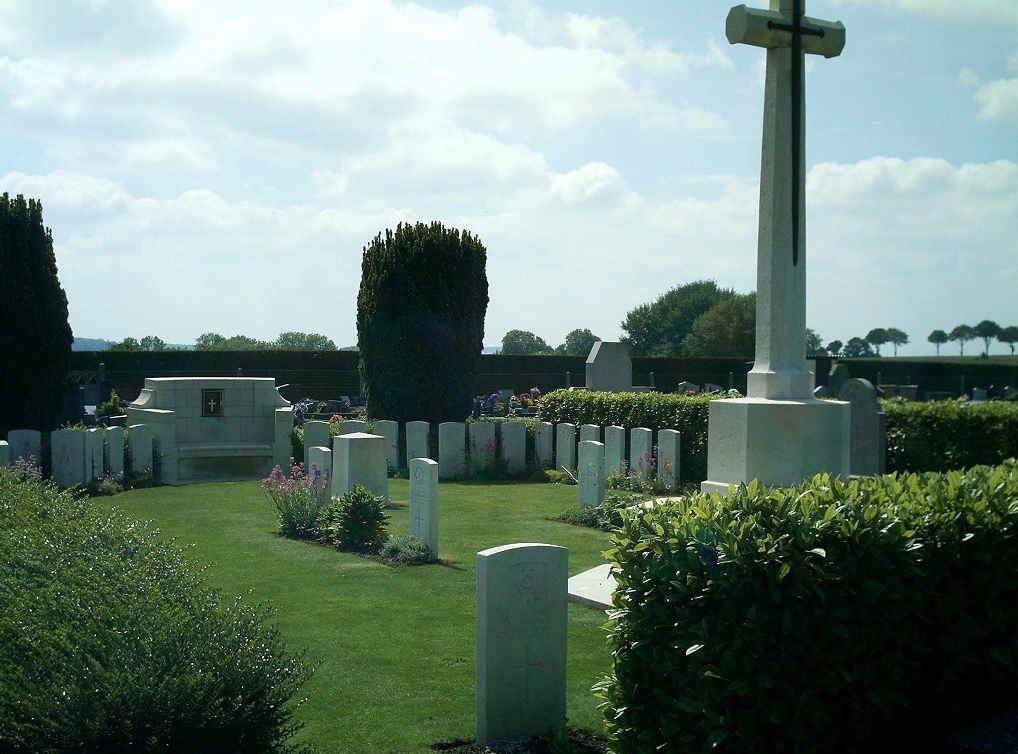 Esnes Communal Cemetery, Nord, France
Esnes Communal Cemetery, Nord, France
Arthur was awarded the 1914 (Mons) Star, British War Medal and Victory Medal, he is commemorated on the L&YR Manchester Victoria Station Memorial and Wigan Cenotaph.
1860 Private Frank Read Manchester Regiment
A record search for Frank’s story proved complicated and frustratingly inconclusive. The loco sheds memorial names a Pte F. Read as having been killed. The L&Y Railway 1915 Roll of Honour seems to confirm this as it shows Frank Read, an engine cleaner at the Wigan depot serving with the local Territorial Force, the 5th Manchester Regiment.
A nationwide search of the 1911 census between the twenty year period of 1880 and 1900 only shows one Frank Read, and he was born in Wigan in 1896. He was the youngest son of William and Catherine Read (nee Murphy). His father, originally from Chorley was a drummer in the Liverpool Regiment and based in Beggars Bush Barracks in Dublin where he married Catherine, who hailed from Tralee in County Kerry. They came back to England and settled in Warrington where William was a miner, then eventually moved to Wigan.
William died in 1897 when Frank was a year old, his mother then remarried to Henry Hunter in 1899. The 1911 census shows Frank living at 22 Poolstock Lane, Wigan with his mother, three brothers, stepfather, three step brothers and a step sister and was working as a colliery surface worker.
Frank enlisted at Bank Chambers in Wigan, the headquarters of the 5th Manchester’s, on 7 April 1914. He was issued the service number of 1860 and assigned to ‘A’ Company. His service records survived unlike millions of others that were destroyed in the Blitz in 1940. Not surprisingly his surname was initially spelt Reid not Read, although it is the same person as his address, 22 Poolstock Lane corresponds with the census address. To add to the confusion his occupation on his enlistment papers is shown as miner when it would expected to have been loco engine cleaner.
The Territorial Force which was envisaged as a ‘Home Service Force’ only, was mobilised for full-time service immediately war was declared on 4 August 1914, this was known as being ‘embodied’. Men enlisting into the Territorial Force did so for a period of four years and were not obliged by their terms of service to serve overseas although they could agree to do so by signing the ‘Imperial Service Obligation’.
Frank did not sign up for overseas service so was posted to the 5th Manchester’s second line unit, the 2/5 th Battalion, who were based at Altcar near Southport. However 2/5th Battalion were destined for active service and moved to Sussex before going to the Western Front in France. In June 1915, men of Territorial Force units who had only volunteered for Home service, including Frank, were formed into composite Provisional Battalions for coastal defence. Frank was attached to ‘C’ Company, 45th Provisional Battalion, 9th Provisional Brigade, who were based at Margate in Kent.
Frank wasn’t a model soldier; his military conduct sheet shows that on 29 March 1916 whilst at Margate he was confined to barracks for seven days for being improperly dressed on parade. On 14 May 1916 he was confined barracks for four days for having a dirty rifle. At Southport on 30 Jan 1915 he was fined two days’ pay and confined to barracks for four days for being absent without leave for two days. Previous to that he was fined two day’s pay and confined to barracks for four days for being absent from roll call whist training at Croxteth, on the outskirts of Liverpool.
On 2 March 1916 the Military Service Act came into force and imposed conscription on all single men aged between 18 and 41. It also swept away the Home/Overseas service distinction and the provisional battalions took on the dual role of home defence and physical conditioning to render men fit for drafting overseas.
Frank was discharged from the army at Margate on 23 June 1916 under the terms of the Military Services Act 1916, having served two years 78 days of his four years engagement. This was a way for the Government to get round the legal conditions that Territorial Forces had attested under upon enlistment.
Now as a civilian again he would be eligible for conscription back into the army in any regiment and this time he wouldn’t have the choice of being a ‘Home Services’ only soldier.
The 1919 L&YR Roll of Honour shows F. Read (presumably the same Frank Read that appeared on the 1915 Roll) as dying in the war. The War Memorials Register which records the list of the fallen on Wigan Cenotaph shows a Frank Read having died whilst serving with the Royal Fusiliers (City of London Regiment).
However there is no record in the Commonwealth War Graves Commission records of a Frank Read (or other alternative spellings such as Reid, Reed or Reade) serving with the Royal Fusiliers and from Wigan as having died during the war. He is not listed on the UK Soldiers Died in the Great War 1914-1919 index nor is there an official War Office Medal Index Card with his name and regiment.
When planning the proposed Cenotaph Wigan Corporation didn’t receive any information on casualties from official sources such as the soldiers regiment or the War Office. They acquired the list of names by putting appeals out through the press for families to come forward with any information such as name, rank and number, regiment and date of death.
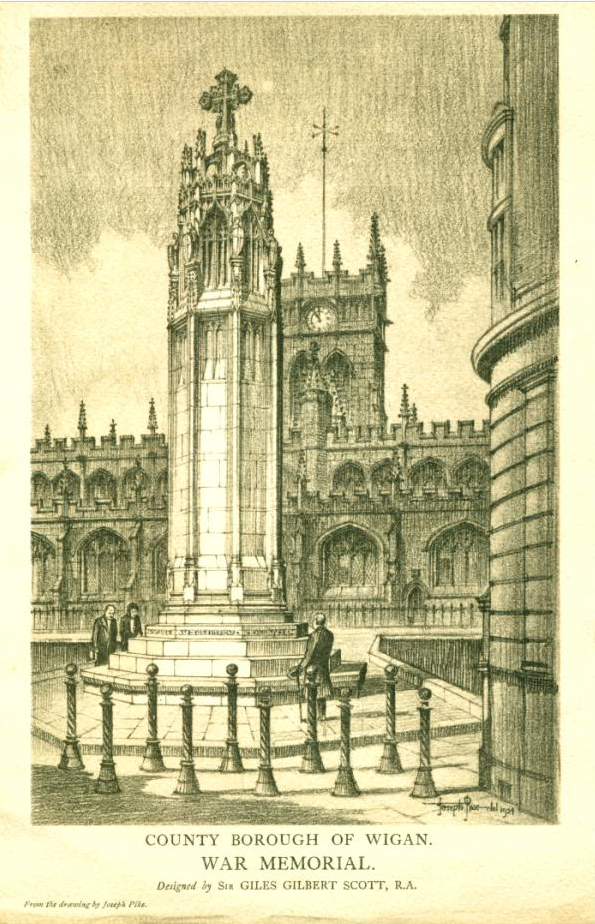 A drawing of the original Wigan Cross by Joseph Pile
A drawing of the original Wigan Cross by Joseph Pile
Wigan Cenotaph (officially known as the Wigan Cross) was erected in 1925, six years after the war had ended. As a result there are several errors in the inscriptions, also more names were added later that had been omitted from the original cenotaph. The fate of F. Read will have to remain a mystery for the time being.
1304 Private Albert Edward Regan Manchester Regiment
Albert was born in 1894 in Newtown, Wigan, the son of William and Elizabeth Annie Regan (nee Appleton). The 1911 census finds him living at 153 Ormskirk Road, Newtown with his parents and younger sister Agnes Maud. Albert was initially employed as a pit brow boy but later moved to the L&YR as a loco engine cleaner.
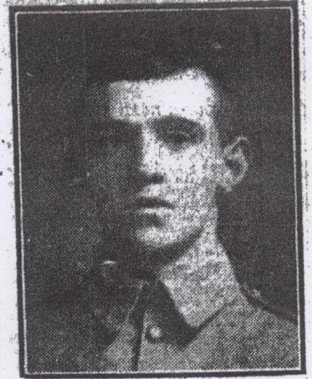 Albert Edward Regan
Albert Edward Regan
Albert enlisted in the 5th Battalion Manchester Regiment, the local Territorial Force unit on 12 February 1912, aged 18. As part of the Middle East Expeditionary Force he sailed from Southampton to Alexandria in Egypt in September 1914. On 6th May 1915 his battalion entered the Theatre of Operations at Gallipoli in the Dardanelles. Three weeks later, on 28 May 1915, twenty one years old Albert was killed in action with B' Company who were occupying front line trenches. The war diary for that day records that the battalion suffered from heavy enfilade fire and casualties for that date were twelve killed in action and thirteen wounded.
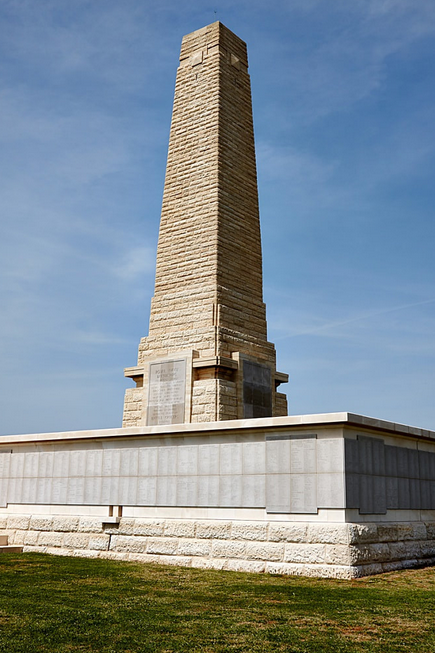 Cape Helles Memorial, Gallipoli
Cape Helles Memorial, Gallipoli
Albert has no known grave and is commemorated on the Cape Helles Memorial at Gallipoli, panel 158-170, stone No. 167. The Helles Memorial is one of five Memorials to the Missing at Gallipoli and contains the names of 20,907 Commonwealth servicemen who have no known grave. Albert is also commemorated on the L&YR Manchester Victoria Memorial, but for some reason not on Wigan Cenotaph. He was awarded the 1914-1915 Star, British War Medal and Victory Medal.
32504 L/Cpl Daniel Smith Royal Army Medical Corps
Daniel was born 7 September 1884 in the village of Grimshaw Green, near Parbold, one of twelve children born to Daniel and Ellen Smith (nee Cottom), both of whom originated from Staffordshire. He was baptised three weeks later at All Saints Parish Church, Wigan.
Daniel married Sarah Emily Flemming on 26 December 1910 at Wigan Parish Church. At the time he was living at 233 Gidlow Lane, Wigan and working as a loco engine fireman for the L&YR. They moved to 50 Warrington Road, Lower Ince where Ellen gave birth to three children, two girls and a boy.
He enlisted into the Royal Army Medical Corps on the outbreak of the Great War and on 18 November 1914 disembarked in France to join the war on the Western Front. Daniel died on 5 August 1915; aged 31, the circumstances of Daniel’s demise are not known but his records show that cause of death was asphyxiation by drowning. He never got to see his son, named Daniel after him, who had been born eleven days previously. His widow Sarah was awarded a pension of 20 shillings and 6 pence per week for her and her children, she remarried and lived in Laxey, on the Isle of Man.
Daniel is buried in Wimereux Communal Cemetery, Pas de Calais, France, Plot I, Row J, Grave 17. On his headstone is inscribed.
'In the midst of life
We are in death
Always remembered'
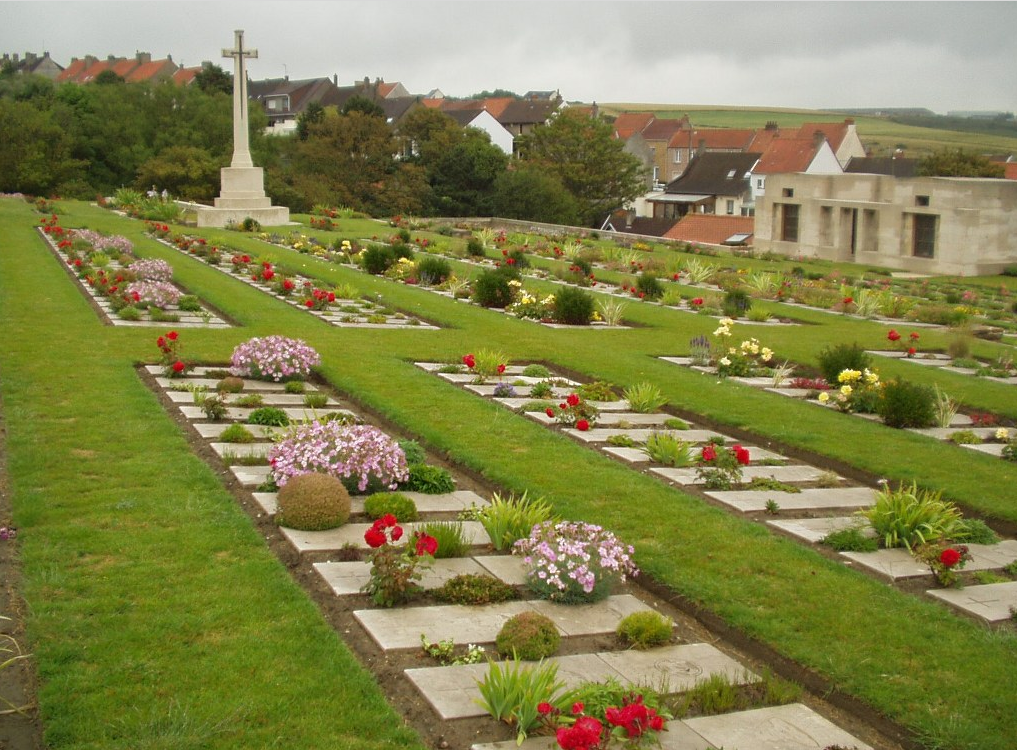 Wimereux Communal Cemetery, Pas de Calais, France
Wimereux Communal Cemetery, Pas de Calais, France
Wimereux lies close to the sea and because of the sandy nature of the soil, the headstones lie flat upon the graves. The cemetery contains 2,847, Commonwealth burials of the First World War, two of them unidentified. Buried among them is Lt.-Col. John McCrae, author of the famous poem 'In Flanders Fields'. There are also five French and a plot of 170 German war graves. The cemetery also contains fourteen Second World War burials, six of them unidentified.
Located on the channel coast, Wimereux was a major base for the British during the Great War. There were at least nine military hospitals based there and close to Boulogne for the wounded to be evacuated back to England. As Daniel was serving with the Royal Army Medical Corps it is possible that he was stationed at one of the hospitals and his death by drowning was not due to enemy action.
Daniel was awarded the 1914 (Mons) Star, British War Medal and Victory Medal, he is commemorated on the L&YR Manchester Victoria Memorial and Wigan Cenotaph.
2033 L/Sgt William Talbot 5th Manchester Regiment
William was born in 1880 in Sandbrook Cottages, Upholland, near Wigan, one of nine children to John and Ann Talbot (nee Liptrot).
When William was a youngster the family moved to 172 Woodhouse Lane, Wigan as William’s father was working as a loco engine cleaner at the L&YR depot. In his youth William was a prominent member of St. Andrew’s Sunday School football team. He was to enlist into the 3rd Volunteer Battalion Lancashire Fusiliers with whom he spent twelve years, serving in Malta, India and South Africa. The 1901 census finds the battalion in barracks at Chatham in Kent.
On his release from the army William returned to Wigan and found employment as a coal miner. By the time of the 1911 census the family had moved the short distance to 141 Woodhouse Lane. Sometime later William started working at the L&YR sheds in Prescott Street as a labourer. His older brother Robert also worked at the depot, eventually becoming an engine driver.
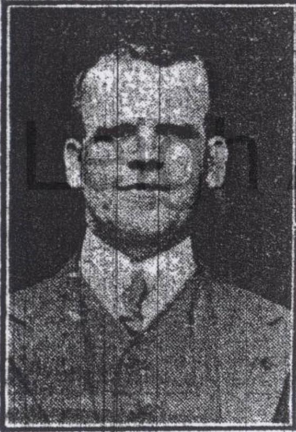 William Talbot
William Talbot
On 5th August 1914, the day following the outbreak of war, William was one of 287 men who enlisted at Wigan Drill Hall into the 1/5th Battalion Manchester Regiment. With his previous military experience he was soon promoted to Lance Serjeant. He was part of the East Lancashire Brigade that sailed out to Egypt in September 1914 and landed on the Gallipoli Peninsula on 6 May 1915. A month later, on 4 June, he was killed in action at the Third Battle of Krithia, aged 34. William has no known grave and is commemorated on the Cape Helles Memorial, Gallipoli, panel 158-170, stone number 159 A, on Wigan Cenotaph, and also on the family grave in St. Thomas The Martyr CE graveyard, Upholland. He was awarded the 1914-1915 Star, British War Medal and Victory Medal.
 Talbot family grave, Upholland.
Talbot family grave, Upholland.
43903 Private Abraham Woodcock Manchester Regiment
Abraham was born 24 November 1880 at 180 Gidlow Lane, Wigan, one of eight children to William Woodcock, an engine winder at a local colliery and Ann (nee Hurst). He was baptised at All Saints Parish Church on 10 January 1881.
By 1901 Abraham was a railway engine cleaner and the family had moved a few doors away to a butcher’s shop run by Abraham’s older brother Edward at 170 Gidlow Lane, next door to the Pagefield Inn. (The now empty Famous Pagefield or as most people know it, the Pagefield Hotel).
In the early 1900’s Abraham was a part time soldier serving with the 1st Volunteer Battalion Manchester Regiment. When his contract was up and he became ‘time served’ he left and married Ellen Smallshaw on 24 February 1906 at St. Annes CE church, Shevington. The 1911 census finds the couple living at 14 Second Avenue, Springfield with their three children. His occupation shows that he had been promoted from engine cleaner to railway loco fireman.
On 10 May 1915 thirty four years old Abraham enlisted in the 2/5th Battalion Manchester Regiment, a Second Line Territorial Force unit, whose headquarters were at Wigan. The battalion was about to move to Sussex for further training in readiness for service on the Western Front, so Abraham was posted to the new third line battalion the 3/5th Manchester’s.
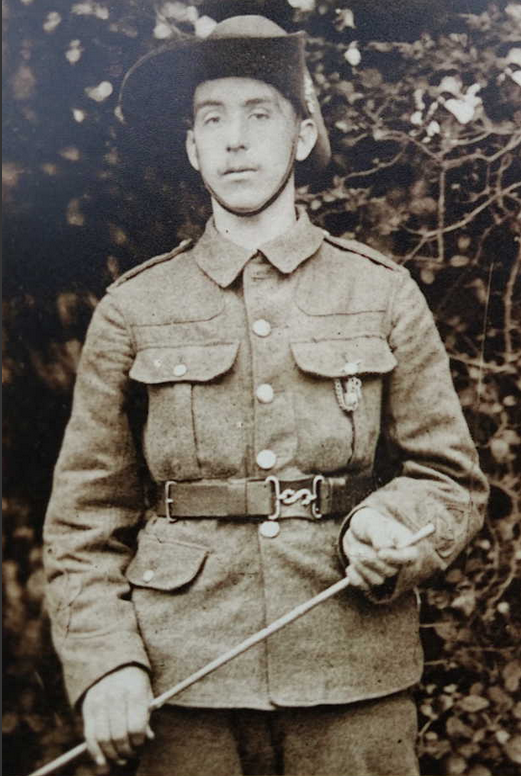 Abraham Woodcock
Abraham Woodcock
On 26 July 1916 Abraham embarked at Folkestone for Boulogne and joined 24 Infantry Base Depot at Etaples, near to the town of Le Touquet on the channel coast. Here he was posted to 5th Battalion Kings (Liverpool) Regiment. Two months later on 20 September he was transferred to 18th (Service) Battalion, Manchester Regiment.
18th Manchester’s spent the whole of December 1916 either in the trenches opposite Blairville, a few miles south east of the much fought over town of Arras, or in Divisional reserve billets at Bailleulval and Basseux.
On 21 December 1916 Abraham was listed as missing believe killed on the battalion casualty list. Determining his fate turned out to be a complicated and drawn out affair. During 1917 his wife Ellen was in contact with the Infantry Records Office at Fulwood Barracks in Preston, and also the War Office, who wanted to know when she had last received a post card from her husband.
His sister Margaret was communicating with the International Red Cross via the Netherlands Legation in Berlin in an effort to find out the facts, as he had been reported as being a prisoner of war in Germany. Until 1917 the USA acted as ‘protecting power’ for British interests. When it entered the war the Dutch, who remained neutral throughout the war took over.
With five children to feed Ellen was in limbo, with the authorities deliberating whether he was a prisoner, in which case she would continue to receive an allowance or if he were dead and she then became entitled to a widow’s pension.
His service records show that the War Office believed that on 26 January 1917 he was a prisoner of war. On 31 October they recorded that he had died in German hands.
The reality of the situation was that Abraham had died the previous year, aged 36, on 28 December 1916, a week after his capture. He was buried by the Germans in Hendecourt-les-Cagnicourt Communal Cemetery, eight miles south east of Arras, in Plot E, Grave 6.
Believing that his grave had been destroyed during the fighting the authorities engraved his name on a Special Kipling Memorial in Croiselles British Cemetery. It reads.
‘To the memory of these Soldiers of the British Empire who died in 1917 as prisoners of war, and were buried at the time in Hendecourt-les-Cagnicourt Communal Cemetery, but whose graves were destroyed in later battles’
An epitaph, written by Rudyard Kipling himself was inscribed thus.
‘Their glory shall not be blotted out'
The Ministry of Pensions in London wrote to the Infantry Records Office in Preston on 22 February 1918 informing them that Abraham’s widow Ellen had been awarded 31 shillings and three pence per week for her and her five children.
A decision was made to exhume all the military burials at Hendecourt-les-Cagnicourt civilian communal cemetery and re-bury them in German and Commonwealth war cemeteries. Abraham’s body was exhumed on 18 March 1930, fourteen years after his death. No identification was found on his body such as identification discs or badges, he was identified solely by his grave number on German prisoner of war records via the International Red Cross.
Abraham was re-interred in Plot I, Row G, Grave 17 in Croiselles British Cemetery, a concentration cemetery to which bodies were brought in from surrounding battlefields after the conflict had ended. The cemetery contains 1,171 commonwealth burials. There are 647 unidentified graves in the cemetery, of these all but two are known to be graves of soldiers from the UK, the other two are unknown soldiers from Canada and Australia.
There are special memorials to 14 casualties and other special memorials to commemorate casualties buried in Hendecourt-les-Cagnicourt Communal Cemetery in 1917, whose graves were destroyed by shellfire. The cemetery also contains the graves of six Commonwealth airmen of World War Two and 18 German war graves.
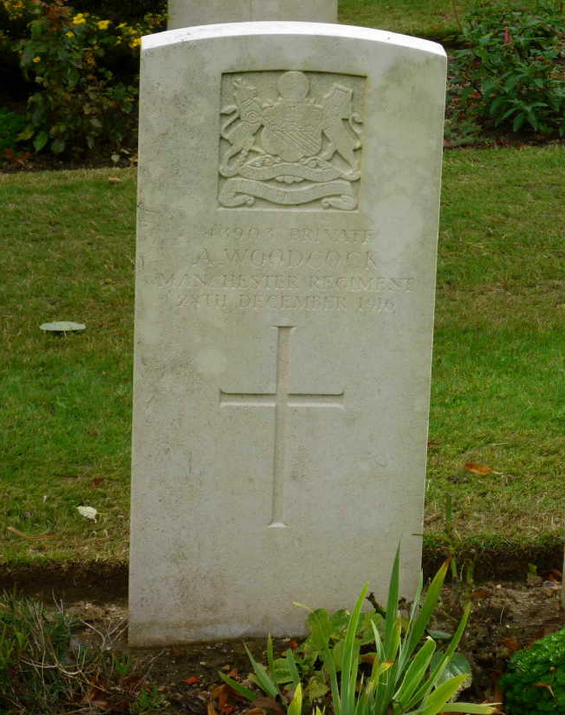 The grave of Abraham Woodcock
The grave of Abraham Woodcock
Abraham was awarded the British War Medal and the Victory Medal and is commemorated on the L&YR Manchester Victoria Memorial and Wigan Cenotaph.
Died out of service
270 Pte Fred Green Kings Royal Rifle Corps
Fred was born 8 August 1893 in Millstone Yard, Wigan Lane, one of thirteen children born to Henry and Elizabeth Green (nee Molyneux). Six of his siblings were to die at a young age.
His father Henry, a house decorator died in 1903 aged 40 when Fred was just nine years of age. The 1911 census finds Fred living at Millstone Yard with his widowed mother, two brothers and a sister. His occupation is shown as colliery labourer underground. Later he gained employment at the L&YR loco sheds as an engine cleaner. Fred’s mother was married for a second time to Job Winrow on 25 May 1912 at St. Michael’s & All Angels CE church Swinley.
Fred enlisted into the King’s Royal Rifle Corps on 19 September 1914. He was discharged, after serving over four and a half years on 7 May 1919 under Kings Regulations, Para 392 xvi, meaning he was released on account of being permanently physically unfit.
Fred died at his home in Millstone Yard on 29 December 1922, aged 29. He is buried in Wigan Cemetery, Lower Ince, grave number M222 CE, along with his parents and two of his siblings.
LEST WE FORGET.
Graham Taylor 2022
Acknowledgements
Thanks to Martin Taylor for supplying information regarding members of the Manchester Regiment.
Photos
Abraham Woodcock and headstone, courtesy of Peter Burns & Ollie Woodcock
Wallgate Memorial, Copyright Brett GWF 2010
Sources
Ancestry
BR Database
Commonwealth War Graves Commission
Find My Past
Forces War Records
Great War Forum
Gwsrsteamloco.blogspot
Imperial War Museum Memorials Register
International Red Cross Archives
Lancashire BMD
Lancs Online Parish Clerk
Rail Scot
The Virtual Museum of the Lancashire & Yorkshire Railway
UK Railway Employment Records 1833-1956
War Memorials Trust
Wigan World
www, locosheds co.uk
www roll of Honour.com/Lancashire – Martin Edwards